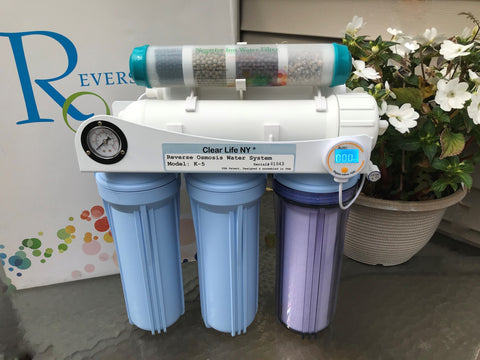How do Reverse Osmosis Filter Systems work ?
How Does Reverse Osmosis Remove Impurities?
Reverse Osmosis water purification process is a simple and straightforward water filtration process. It is accomplished by water pressure pushing tap water through a semipermeable membrane to remove impurities from water. This is a process in which dissolved inorganic solids (such as salts) are removed from a solution (such as water).
Water Filter Presentation Animated Video:
https://www.youtube.com/watch?v=pdwp6S1lrP0




5-stage Reverse Osmosis Filtration Process Video:
https://www.youtube.com/watch?v=zyYP5VHPifM
Millions of American households and businesses love Reverse Osmosis (RO) because:
- RO produces great-tasting water
- RO is effective and safe
- RO filtration is fully automated
- RO systems are reasonably priced
If you’re looking for a water filter that will provide outstanding drinking water for your home or business, Reverse Osmosis (RO) filtration is one of the most popular and best water filtration methods available. In simple terms, reverse osmosis works as water is forced across a semi-permeable membrane, leaving contaminants behind that are flushed down the drain. The clean drinking water collects in a holding tank.
Installed at the kitchen sink: A small RO filtration system can be installed at the kitchen tap to provide top-quality drinking water. This is called a “point of use” (POU) water filtration system and can also connect to your fridge and ice machine. Water pressure is a consideration with some refrigerators, so be sure to refer to your RO system’s owner’s manual as the pressure from the Reverse Osmosis unit is about two-thirds of the incoming line pressure.
Why Choose Reverse Osmosis?
1 Improves Taste
RO filtration improves the taste, odor, and appearance of water by removing contaminants that cause taste and odor problems.
2 Saves Money
With an RO system, you can cancel your water delivery service and stop purchasing cases of bottled water. Reverse Osmosis filtration provides “better-than-bottled water” quality water for just pennies per gallon.
3 Simple Maintenance
RO systems have very few moving or replaceable parts that make RO systems easy to clean and service.
4 Removes Impurities
RO systems remove pollutants from water including nitrates, pesticides, sulfates, fluoride, bacteria, pharmaceuticals, arsenic, and much more. RO systems’ carbon filter will also remove chlorine and chloramines.
Reverse osmosis (RO) is a water purification process that uses a partially permeable membrane to remove ions, unwanted molecules and larger particles from drinking water. In reverse osmosis, an applied pressure is used to overcome osmotic pressure, a colligative property that is driven by chemical potential differences of the solvent, a thermodynamic parameter. Reverse osmosis can remove many types of dissolved and suspended chemical species as well as biological ones (principally bacteria) from water, and is used in both industrial processes and the production of potable water. The result is that the solute is retained on the pressurized side of the membrane and the pure solvent is allowed to pass to the other side. To be "selective", this membrane should not allow large molecules or ions through the pores (holes), but should allow smaller components of the solution (such as solvent molecules, i.e., water, H2O) to pass freely.[1]
In the normal osmosis process, the solvent naturally moves from an area of low solute concentration (high water potential), through a membrane, to an area of high solute concentration (low water potential). The driving force for the movement of the solvent is the reduction in the free energy of the system when the difference in solvent concentration on either side of a membrane is reduced, generating osmotic pressure due to the solvent moving into the more concentrated solution. Applying an external pressure to reverse the natural flow of pure solvent, thus, is reverse osmosis. The process is similar to other membrane technology applications.
History of Reverse Osmosis
Reverse osmosis is not a new purification technique. The first example of osmosis through semipermeable membranes was described by Jean-Antoine Nollet in 1748. While the process was known in laboratories, it wasn't used for desalination of seawater until 1950 at the University of California in Los Angeles. Multiple researchers refined methods of using reverse osmosis to purify water, but the process was so slow that it wasn't practical on a commercial scale. New polymers allowed for the production of more efficient membranes. By the beginning of the 21st century, desalination plants became capable of desalinating water at the rate of 15 million gallons per day, with around 15,000 plants in operation or planned.

